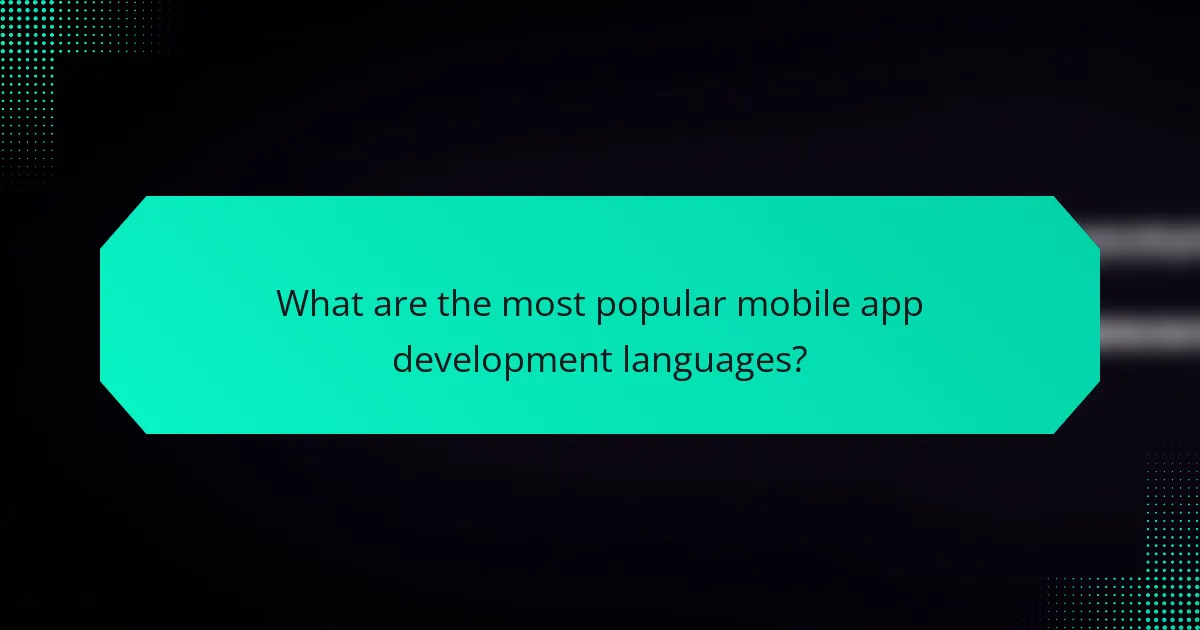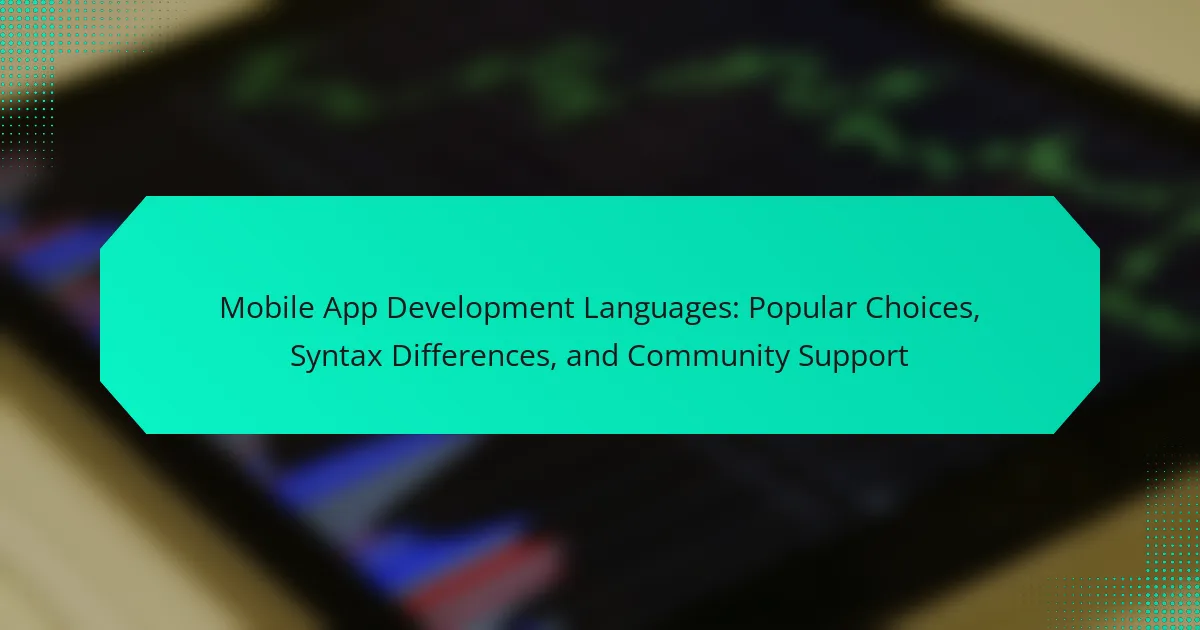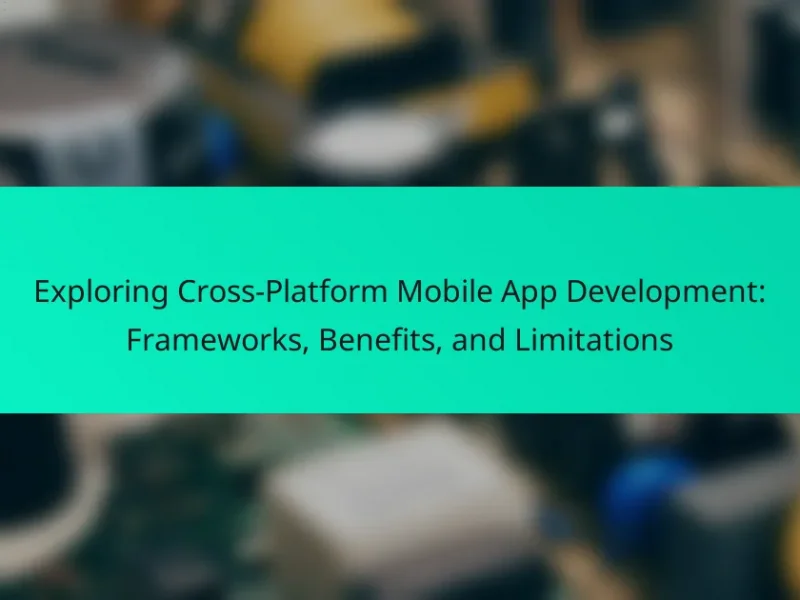Mobile app development languages include Java, Swift, Kotlin, and JavaScript, each with unique syntax and community support. Java is primarily used for Android development, while Swift is the main language for iOS applications. Kotlin has emerged as a popular alternative to Java for Android, and JavaScript is crucial for cross-platform development through frameworks like React Native. Syntax differences among these languages impact their usability and learning curve, with Java being more verbose, Swift emphasizing readability, and JavaScript offering flexibility. Community support plays a vital role in the adoption and evolution of these languages, as active communities provide resources that facilitate learning and problem-solving for developers.

What are the most popular mobile app development languages?
The most popular mobile app development languages are Java, Swift, Kotlin, and JavaScript. Java is widely used for Android development. Swift is the primary language for iOS applications. Kotlin has gained popularity as an alternative to Java for Android. JavaScript is essential for cross-platform development using frameworks like React Native. According to the Stack Overflow Developer Survey 2023, Java and JavaScript consistently rank among the top languages used by developers. Swift has seen significant adoption since its release in 2014, particularly among iOS developers.
Why do developers choose specific languages for mobile app development?
Developers choose specific languages for mobile app development based on factors like performance, platform compatibility, and community support. Performance is crucial for user experience; languages like Swift and Kotlin are optimized for iOS and Android, respectively. Platform compatibility influences choices; cross-platform frameworks like React Native allow code reuse across devices. Community support is vital for troubleshooting and resources; languages with large communities offer extensive libraries and documentation. Additionally, familiarity with a language can speed up development. According to a Stack Overflow survey, 30% of developers prefer JavaScript for mobile development due to its versatility and widespread use.
What factors influence the choice of programming languages?
The choice of programming languages is influenced by several key factors. These factors include project requirements, performance needs, and developer expertise. The specific application domain often dictates language suitability. For instance, mobile app development often favors languages like Swift or Kotlin. Performance considerations can lead developers to choose lower-level languages for efficiency. Additionally, the existing skill set of the development team plays a crucial role. Familiarity with a language can significantly reduce development time. Community support and available libraries also affect language selection. A strong community can provide resources and troubleshooting assistance, enhancing productivity.
How do target platforms affect language selection?
Target platforms significantly influence language selection in mobile app development. Different platforms have specific requirements and constraints that dictate suitable programming languages. For instance, iOS apps primarily use Swift or Objective-C due to Apple’s ecosystem. Android development predominantly employs Java or Kotlin, as these languages are optimized for the Android operating system.
Additionally, cross-platform frameworks like React Native and Flutter allow developers to use JavaScript and Dart, respectively. These frameworks enable code sharing across platforms, making them popular choices for multi-platform development.
The choice of language also affects performance, user experience, and access to platform-specific features. Languages designed for a particular platform often provide better integration and efficiency. Therefore, understanding the target platform is crucial for selecting the appropriate language in mobile app development.
What are the key features of the top mobile app development languages?
The key features of the top mobile app development languages include performance, ease of use, and community support. Performance refers to how efficiently the language executes tasks. For instance, Swift offers high performance for iOS development. Ease of use indicates how accessible the language is for developers. JavaScript is known for its simplicity and widespread use in web-based applications. Community support reflects the availability of resources and assistance. Languages like Java and Kotlin have strong communities, providing extensive libraries and frameworks. Additionally, cross-platform capabilities are crucial. Languages such as Flutter and React Native allow developers to create apps for multiple platforms using a single codebase.
What distinguishes Java from Kotlin in mobile app development?
Java is a statically typed programming language primarily used for mobile app development on Android. Kotlin, on the other hand, is a modern programming language that is fully interoperable with Java. One key distinction is Kotlin’s concise syntax, which reduces boilerplate code compared to Java. This leads to faster development and fewer errors.
Kotlin also includes features such as null safety, which helps prevent null pointer exceptions, a common issue in Java. Additionally, Kotlin supports functional programming paradigms, enhancing code flexibility. Java has a larger legacy codebase and a more extensive community support due to its long-standing presence in the industry.
Kotlin has gained popularity as the preferred language for Android development since Google announced it as an official language in 2017. According to the 2021 Stack Overflow Developer Survey, Kotlin was ranked as the second most loved language among developers.
How does Swift compare to Objective-C for iOS applications?
Swift offers a modern and streamlined approach compared to Objective-C for iOS applications. Swift features a more concise syntax, making it easier to read and write. It eliminates many of the complexities found in Objective-C, such as manual memory management. Swift also includes safety features that help prevent common programming errors. For instance, it has optionals that handle null values more effectively. Objective-C, on the other hand, relies on a longer syntax and is less forgiving with memory management. Swift has gained popularity, as evidenced by its rapid adoption in the developer community since its release in 2014. According to the Stack Overflow Developer Survey 2023, Swift ranks among the top programming languages for mobile development. This indicates a strong community support for Swift, which is essential for developers seeking resources and libraries. Overall, Swift’s modern syntax and safety features make it a preferable choice for new iOS applications compared to Objective-C.
What trends are emerging in mobile app development languages?
Emerging trends in mobile app development languages include the rise of cross-platform frameworks and increased use of Kotlin. Cross-platform frameworks like Flutter and React Native allow developers to write code once and deploy it on multiple platforms. This trend enhances efficiency and reduces development time. Kotlin has gained popularity as the preferred language for Android development, officially supported by Google since 2017. The use of Swift for iOS development continues to grow, emphasizing performance and safety. Additionally, the integration of AI and machine learning capabilities into mobile apps is driving the demand for languages that facilitate these technologies. Overall, the focus is shifting towards languages that support rapid development and cross-platform compatibility.
How is the rise of cross-platform frameworks changing language preferences?
The rise of cross-platform frameworks is shifting language preferences towards those that support multiple platforms. Developers are increasingly choosing languages like JavaScript, Dart, and C# for their versatility. Cross-platform frameworks such as React Native and Flutter enable code sharing across iOS and Android. This reduces development time and costs significantly. For instance, React Native allows up to 90% code reuse. Consequently, demand for traditional languages like Swift and Java may decline. Surveys indicate that developers prioritize efficiency and speed in their projects. As a result, language preferences are evolving to favor those that integrate well with cross-platform solutions.
What role does community support play in the popularity of programming languages?
Community support significantly influences the popularity of programming languages. A strong community provides resources such as tutorials, forums, and libraries. This accessibility encourages new developers to learn and adopt the language. Additionally, community-driven projects enhance the language’s capabilities and features. For example, languages like Python and JavaScript have thriving communities that contribute to extensive documentation and third-party libraries. According to the Stack Overflow Developer Survey, languages with robust community support consistently rank higher in usage and developer satisfaction. This trend illustrates that community engagement directly correlates with a language’s popularity and longevity in the industry.

What are the syntax differences among popular mobile app development languages?
Java, Swift, and JavaScript are popular mobile app development languages with notable syntax differences. Java uses a verbose syntax with explicit type declarations and semicolons to end statements. Swift, on the other hand, has a concise syntax that emphasizes readability and uses type inference. JavaScript features a flexible syntax that allows for dynamic typing and supports both object-oriented and functional programming styles.
Java requires class definitions for all code, while Swift allows for more straightforward function definitions outside of classes. JavaScript uses curly braces to define code blocks, similar to Java, but allows for more lenient variable declarations. Swift includes features like optionals for handling null values, which Java and JavaScript do not inherently support.
These differences impact the learning curve and usability of each language. Java’s syntax can be more challenging for beginners due to its complexity. Swift’s and JavaScript’s simpler syntax can make them more accessible. Each language’s syntax reflects its design philosophy and intended use cases in mobile app development.
How does syntax impact the learning curve for new developers?
Syntax significantly impacts the learning curve for new developers. A clear and intuitive syntax can accelerate comprehension and reduce errors. For example, languages like Python feature straightforward syntax, making it easier for beginners to grasp programming concepts quickly. Conversely, languages with complex syntax, such as C++, can create additional hurdles for novices. Research shows that developers often prefer languages that minimize syntactical complexity. This preference can lead to faster adoption and proficiency. According to a study by Stack Overflow, developers favor languages with simpler syntax, impacting their choice of tools for projects. Thus, syntax plays a crucial role in shaping the learning experience for new developers.
Which languages have the most user-friendly syntax?
Python, JavaScript, and Ruby have the most user-friendly syntax. Python’s syntax is clear and intuitive, making it accessible for beginners. JavaScript is widely used for web development and has a syntax that is easy to learn. Ruby emphasizes simplicity and productivity, featuring a readable syntax. Studies show that these languages are favored in educational settings for their ease of use. For instance, Python is often recommended for teaching programming due to its straightforward structure. JavaScript’s popularity in web development further validates its user-friendly nature. Ruby’s design philosophy prioritizes developer happiness, enhancing its appeal.
What are common syntax errors in mobile app development languages?
Common syntax errors in mobile app development languages include missing semicolons, unmatched brackets, and incorrect variable declarations. Missing semicolons can lead to unexpected behavior in languages like JavaScript and Java. Unmatched brackets create issues in languages such as Swift and Kotlin, causing compilation errors. Incorrect variable declarations can result from using the wrong data type or not initializing a variable. These errors are frequent among both novice and experienced developers. Specific programming environments often highlight these errors for easier debugging. Understanding these common mistakes can help developers write cleaner code.
What are the best practices for writing clean code in mobile app development?
The best practices for writing clean code in mobile app development include maintaining readability, using meaningful variable names, and following consistent formatting. Readable code helps developers understand the logic and flow. Meaningful variable names provide context and improve code clarity. Consistent formatting, such as indentation and spacing, enhances visual structure.
Additionally, modular design is essential. Breaking code into smaller, reusable functions simplifies maintenance. Commenting code judiciously clarifies complex logic without cluttering. Regular code reviews foster collaboration and identify potential issues early. Automated testing ensures code reliability and reduces bugs.
These practices are supported by the Clean Code principles outlined by Robert C. Martin. His book emphasizes the importance of writing understandable and maintainable code. Following these guidelines leads to higher-quality mobile applications.
How can developers maintain consistency in coding style?
Developers can maintain consistency in coding style by adopting coding standards and guidelines. These standards provide a clear framework for writing code. Utilizing tools like linters and formatters helps enforce these guidelines automatically. Code reviews also promote adherence to standards through peer feedback. Consistent naming conventions improve readability and maintainability. Documentation of coding practices aids in onboarding new team members. Regularly updating standards keeps them relevant as technology evolves. Collectively, these practices foster a cohesive coding environment.
What tools can assist in syntax error detection?
Integrated Development Environments (IDEs) assist in syntax error detection. Popular IDEs like Visual Studio Code, IntelliJ IDEA, and Eclipse provide real-time syntax checking. These tools highlight errors as developers write code. They often include features like code completion and suggestions. Linters such as ESLint and Pylint also help by analyzing code for syntax errors. They provide feedback on coding standards and potential issues. Static analyzers like SonarQube enhance error detection by examining code without executing it. These tools improve code quality and reduce debugging time.

How does community support influence mobile app development languages?
Community support significantly influences the choice of mobile app development languages. A strong community provides resources, libraries, and frameworks that enhance language usability. Developers often gravitate towards languages with active communities for easier problem-solving. For instance, languages like JavaScript and Swift have large communities that contribute to extensive documentation and forums. This support accelerates learning and troubleshooting for new developers. Additionally, community-driven projects can lead to the evolution of language features based on user feedback. Popularity metrics show that languages with robust community backing, such as Python and Kotlin, often see increased adoption rates. Ultimately, community support shapes the ecosystem of mobile app development languages by fostering collaboration and innovation.
What resources are available for developers seeking community support?
Developers seeking community support can access several valuable resources. Online forums like Stack Overflow provide a platform for asking questions and sharing knowledge. GitHub offers a collaborative environment for developers to contribute to open-source projects and seek assistance. Social media platforms such as Twitter and LinkedIn host groups and discussions focused on specific programming languages and technologies. Meetup groups and local coding workshops facilitate in-person networking and learning opportunities. Additionally, dedicated communities like Reddit have subreddits for various programming languages, fostering discussion and support. These resources collectively enhance collaboration and problem-solving among developers.
How can forums and online communities enhance learning?
Forums and online communities enhance learning by providing collaborative environments for knowledge sharing. They allow users to ask questions and receive answers from experienced members. This interaction fosters a deeper understanding of complex topics. Communities often offer resources such as tutorials and guides. Users can share personal experiences, which enriches the learning process. Additionally, forums create networking opportunities among learners and professionals. This networking can lead to mentorship and collaboration on projects. Research shows that peer interaction significantly boosts retention and comprehension rates in educational settings.
What role do open-source projects play in community engagement?
Open-source projects significantly enhance community engagement by fostering collaboration and knowledge sharing. They allow developers to contribute code, report issues, and suggest improvements. This collaborative environment encourages diverse perspectives and innovation. Open-source projects often create a sense of ownership among contributors, leading to sustained involvement. Additionally, they provide opportunities for learning and mentorship within the community. According to the 2020 Open Source Survey, 92% of developers believe that open-source participation is beneficial for career growth. This statistic underscores the importance of open-source projects in building professional networks and skills.
What are the benefits of engaging with the developer community?
Engaging with the developer community offers numerous benefits for mobile app development. It fosters collaboration, allowing developers to share knowledge and solve problems collectively. Access to diverse perspectives enhances creativity and innovation in app design. Networking opportunities can lead to job prospects and partnerships. Community support provides resources like tutorials, documentation, and forums for troubleshooting. Participation in discussions can keep developers updated on industry trends and best practices. According to a Stack Overflow survey, 90% of developers find community engagement valuable for professional growth.
How does collaboration within communities lead to better app development?
Collaboration within communities leads to better app development by fostering knowledge sharing and collective problem-solving. Developers can exchange ideas, resources, and best practices. This interaction results in faster identification of bugs and more innovative solutions. Community feedback helps refine app features and enhance user experience. Open-source projects benefit significantly from collaborative contributions. According to a study by GitHub, collaborative coding improves code quality and reduces development time. Additionally, communities provide support networks that encourage continuous learning and skill development. This synergy ultimately results in more robust and user-friendly applications.
What are some effective ways to contribute to mobile app development communities?
Engaging in mobile app development communities can be achieved through various effective methods. Contributing code to open-source projects is a significant way to help. This enhances skills and provides practical experience. Answering questions on forums like Stack Overflow also supports fellow developers. Sharing knowledge through blog posts or tutorials can educate others. Participating in local meetups fosters networking and collaboration. Offering mentorship to beginners builds a stronger community. Contributing to documentation improves resources for all users. These actions collectively strengthen mobile app development communities.
What tips can help developers choose the right mobile app development language?
Developers should consider project requirements when choosing a mobile app development language. This includes the platform, performance needs, and user experience goals. They should also evaluate the language’s popularity and community support. A strong community can provide resources and assistance. Additionally, developers should assess their own proficiency with the language. Familiarity can reduce development time and increase efficiency. Compatibility with existing tools and frameworks is also essential. This can streamline the development process. Finally, developers should consider future maintenance and scalability. A well-supported language can facilitate updates and enhancements over time.
Mobile app development languages, including Java, Swift, Kotlin, and JavaScript, play a crucial role in creating applications for various platforms. This article explores the factors influencing developers’ language choices, such as performance, platform compatibility, and community support. It highlights the syntax differences among popular languages, the impact of community engagement on language popularity, and emerging trends like cross-platform frameworks. Additionally, the article discusses best practices for writing clean code and the importance of collaboration within developer communities for enhancing app development.


